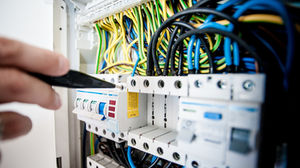Is Thermal Scanning Really Enough?
- accounts312
- Jul 23, 2017
- 3 min read
If you are in the electrical industry chances are you also know about thermal scanning. Adapted over time from high end uses such as military cases, thermal scanning has slowly been adopted in the electrical industry as one of the only forms on non-destructive testing one can perform on a live switchboard... BUT there is more that can be done.
Thermal scanning definitely has its benefits as it allows the user to 'see' in a infra red (IR) spectrum beyond what is visible to the naked eye, but it is what can be SEEN by the naked eye that often gets overlooked by camera users as they focus on the IR image alone.

Used to detect areas of 'abnormal heat', thermal scanning is implemented a preventive measure to highlight possible causes of fire or electrical breakdown of electrical equipment. The Australian Standards have tried to standardise the use and implementation of thermal cameras by introducing accreditation courses; however the detection, analysis and reporting of potential problems often comes down to user experience and contractor knowledge.
But Is It Really Enough??
In the electrical industry thermal scanning is highly competitive, with varying levels of competency and quality of work. The site contractor is often pushed to get the work done as quickly as possible and move on to the next site. This in itself is the core of the issue, as from switchboard to switchboard less and less time is spent actually 'looking' for issues, so if nothing shows up in the overall scan as being abnormally 'hot' its just put the cover on, shut the door and move on.
Take the above switchboard, for example. From the overall scan nothing in the image is operating at over 41 degrees, giving the user no inclination to 'zoom in' and check out anything further - a classic shut the door and move on scenario.
But take a look at what is actually there...

A burnt cable presenting an immediate hazard to the building and occupants.
See how we found it! - Read below
It is exactly these issues that get overlooked by contractors as they only look to do the bare minimum, because hey, they are only there "to look down the thermal camera" so why actually DO any more??
For reference, this contactor is on the upper row at the far LHS in the above image. Even looking at the infrared image of the cable it gives no indication that is has been burnt and is a potential fire hazard.
The Corsence Difference
Here at Corsence we have been advocating these associated limitations of thermal scanning for some time now. Yes, we still believe it should be done but it should be coupled with a more detailed inspection so that various other critical hazards can be pinpointed all while the switchboard is live and the cover is removed.
For this, we use SwitchSafes' self automated switchboard inspection application, which covers all the essential fire, safety and electrical hazards that can be identified with the naked eye. It is designed to be coupled with annual thermal scanning to provide a PREMIUM level of risk mitigation all in an additional 5-10mins per switchboard.
It may also save $$$ on annual switchboard maintenance as most of the items have already been covered under the SwitchSafe inspection, so the outage time can be spent on more critical items and essential repair works.

- Take your risk RISK MITIGATION to a PREMIUM level -

- Self automated reporting
- In built standard and legislation reference checks
- Checklist completion
- Digital images recorded for reference
- Priority summary generation
- Easy rectification works list extraction
Click the link below for more info!
Since implementing SwitchSafes' inspection app at various sites, Corsence have yielded a 100% strike rate in finding issues like the above burnt cable that thermal scanning didn't detect. To join the people doing more and take your facilities' risk management to the next level send us an email at connect@corsence.com














